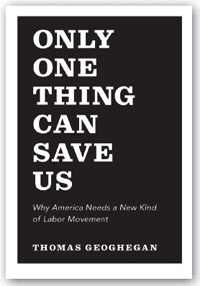
Only One Thing Can Save Us: Why America Needs a New Kind of Labor Movement
Thomas Geoghegan
255 pages, New Press, 2014
In Only One Thing Can Save Us, Tom Geoghegan joins the growing chorus of voices who have called for a fundamentally new approach to empowering workers in the United States. Salvation, in his view, can come only from rebuilding the labor movement—rebuilding it from the ground up and in ways that aren’t chained to the ossified doctrines of current labor law or the bureaucratic structures of existing unions.
Geoghegan presents this argument with the passion and energy that many of us have come to expect from him. He’s a highly regarded labor lawyer and a loyal, principled warrior for worker’s rights. His vibrant, conversational style makes you feel as if you’re talking with him during a long, caffeine-fueled visit to his favorite coffeehouse. Drawing on his experience in fighting legal battles for workers, he offers thrilling tales of success and (more often) failure. Unlike many of his labor law brethren, he has come away from these battles not discouraged by defeat but open to new ideas.
Only One Thing starts with a call to make joining a union a civil right. Under that doctrine, the same penalties that apply to firing people because of their race, sex, or age would apply to firing people for organizing a union. Taking this step would have several benefits.
First, it would impose real economic costs on employers who violate the law. (The remedies available to fired organizers under current labor law are practically meaningless.) Second, it would strike fear into managers because they would be subject to the court- ordered “discovery” of information about their hiring and firing decisions. Third, it would give workers control over whether to bring legal action against an employer. ( Today, they can do so only with the support of a union or the National Labor Relations Board.) This idea isn’t new. Back in 1994, when I was a member of the Dunlop Commission on the Future of Worker Management Relation, my colleagues and I discussed it. But the fierce opposition that the idea generated then—and still generates today— suggests that it has enormous merit.
The second idea that Geoghegan offers is more radical: Let the “right to work” doctrine take hold in every state. That way, labor advocates would neutralize the argument that unions force people who don’t want union representation to pay union dues. He acknowledges the problem of “free riders”—workers who get the benefits of representation without paying for them. But he has a solution. State and federal authorities, he writes, should drop the requirement of exclusive representation, which dictates that a union can bargain for a group of workers only if a majority of those workers support it. When a union gains that status, it suffers the winner’s curse of having to represent all the workers, regardless of whether they join the union. Many labor law scholars have argued that current law permits members-only representation. Indeed, the United Auto Workers is now pursuing that approach at the Volkswagen plant in Chattanooga, Tenn.
Another idea is to focus not on labor law but on corporate law. Geoghegan argues for testing European-style works councils, which give workers a voice in advising management, and for revising company charters to allow worker representation on corporate boards of directors. At the least, he suggests, workers should be able to sue corporate directors for breach of fiduciary responsibility.
Geoghegan also urges state and federal agencies to use their purchasing power to press companies to comply with labor standards both at home and abroad. In the 1960s, President Lyndon B. Johnson signed an executive order that requires government contractors to take affirmative steps to eradicate racial discrimination in their employment practices. Why not apply the same principle to companies that discriminate against people who want to join a union?
What’s missing from this survey of tactics? Unable to cast off his lawyer’s cloak, Geoghegan fails to see that young organizers and social entrepreneurs are using social media and other new technologies to transform the process of mobilizing people. As he notes, the traditional strike is dead. Instead, labor activism has increasingly become a matter of building public support through media—social and otherwise. But efforts to harness the power of social media for labor organizing have only just begun, and the best ideas for doing so will come not from aging lawyers (or from college professors!) but from the next generation of activists.
Those activists are not shackled by the constraints of labor law or union bureaucracy. Consider the young organizers of the Restaurant Opportunities Centers United (ROC), a group that seeks to mobilize low-wage workers in the food service industry. The organizers insist that ROC is not a union—even as industry lawyers are urging authorities to designate it as one so that they can use current labor law to straitjacket the group.
None of the ideas put forth by Geoghegan is completely original. But it’s great to see a longtime defender and ally of the labor movement take them seriously. Nothing, it seems, is off-limits anymore.

